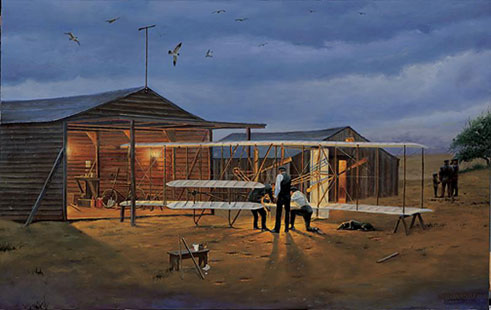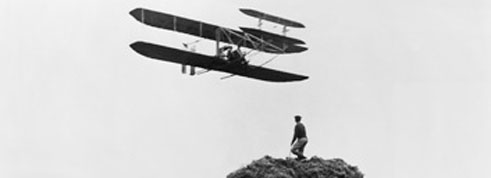47. Wilbur and Orville Wright and the Invention of the Airplane
Located: 3rd floor, conference room inside Courtroom 5 vestibule
Print in courthouse exhibit: Dave Barnhouse, Preflight Check at Kitty Hawk
Other image of interest: Photo of early Wright Brothers flight
The genius of two young, self-taught brothers from Dayton, Ohio frames the story of their remarkable entrepreneurship. This essay provides an overview of their studies, experiments, and ultimate achievement of controlled, powered flight at the turn of the twentieth century.

Wilbur and Orville Wright and the Invention of the Airplane
The Wright brothers' 1903 invention of a controlled, powered airplane capped untold centuries of attempts by man to fly. While the first manned hot air balloon was flown over France in 1783, other major aviation advances were slow to follow. By the late 1800s, British, German and American scientists had contributed well-reasoned ideas and models for flying machines. Still, the tantalizing possibility of controlled, sustained, piloted flight dogged the increasingly modern world.
Wilbur and Orville Wright, young entrepreneurs from Dayton, Ohio, had long shared an interest in aviation. Although neither brother had completed high school, both were bright, curious, and mechanically talented. Since 1893, the brothers had sold, repaired and built bicycles using their own original parts.
The difficulties encountered by aviation’s early pioneers kindled the Wrights’ curiosity about piloted flight. They read what they could on the subject, from every available source. The brothers concluded that control was the essential element to be solved. “When this one feature has been worked out, the age of flying machines will have arrived,” noted Wilbur, “for all other difficulties are of minor importance.”
The Wrights discarded conventional thought that an aircraft must itself be stable. As with a bicycle, they believed that controlling an aircraft would require adjustments for balance while in motion. They figured that lateral balance could be achieved if the angles for wings on either side were equally maneuverable. This capability would allow an aircraft to be stabilized during flight, as well as to be banked for turns.
The solution came unexpectedly one summer day in 1899. While talking with a customer in the shop, Wilbur idly played with a long, thin cardboard box for a bicycle inner tube. He squeezed opposing diagonal corners on each end of the box, noticing that as the box twisted, it retained its lateral integrity. Wilbur realized that this twisting effect could be used to change the angles of opposing biplane wings.
This new concept of “wing warping” was key to the Wrights’ invention of the first practical airplane. However, other important discoveries achieved through the brothers’ research and experimentation were equally important in the process. After traveling to Kitty Hawk, North Carolina for not-so-successful glider test flights in 1900 and 1901, the brothers built a wind tunnel in the back of their bicycle shop in order to test 200 different wing shapes for their effects on lift and drag.
In 1902, the Wrights ventured back to Kitty Hawk. Their new glider featured long, narrow wings and three-axis control: a forward elevator for pitch (up and down direction), wing warping for roll (lateral balance), and a movable, rear rudder for yaw (side to side motion). The brothers flew the glider almost 1,000 times that fall, with its longest glide covering 622 feet in 26 seconds. Their invention of three-dimensional control, and the first precisely balanced aircraft, was an enormous breakthrough in aviation.
The Wright Flyer I, the first fully controlled, powered airplane, was completed in 1903. Wilbur and Orville had sculpted the wooden propellers themselves. Their bicycle shop mechanic, Charlie Taylor, built a gravity-fed, gas-powered engine cast from aluminum to suit the aircraft’s limited weight requirements. At Kitty Hawk on December 17, 1903, the brothers piloted their powered flying machine four separate times, ultimately achieving a flight lasting close to a full minute. Wilbur and Orville Wright’s mastery of sustained and controlled flight, after just seven years of study and experimentation, was a remarkable achievement. Having paid attention to the lessons of earlier trials, challenged long-held assumptions, and diligently tested data and designs, the young innovators revolutionized the science of aviation and surprised the world with their sudden success. Most importantly, the Wright brothers had opened a door to the future. Their work in aerodynamics and their invention of three-axis control ushered in tremendous advancements in aviation, and many twentieth-century American achievements. Their discoveries played a fundamental role in Robert Goddard’s 1926 launch of the world’s first liquid fuel rocket in Auburn, Massachusetts. In 1927, Charles A. Lindbergh completed a solo trans-Atlantic airplane flight, piloting his Spirit of St. Louis from New York to Paris in 33 ½ hours. A thriving industry serving commercial air travel, as well as military and scientific purposes, spawned more discoveries at an astounding pace. In 1947, Charles Yeager became the first pilot to exceed the speed of sound; ten years later, space exploration became a reality. By 1969, astronauts Neil Armstrong and Edwin “Buzz” Aldrin stepped out of the Apollo 11 Lunar Module and, incredibly, onto the surface of the moon.







